Alternative photographic processes. Even the name feels a bit of a misnomer. Alternative to what? The centuries old processes may be an alternative to the current world of digital image making, but as an alternative to photographic image making, I take issue with the name. If processes date back to the mid-18th century, why are they not called “primary” processes? This is a futile argument, of course. Only a handful of people would even get riled up over this pithy choice of words. But it speaks to a deeper issue for me. I feel that almost every process I utilize is “alternative.” Perhaps by rejecting the status quo I am acting (creating) in an alternative manner. Whether its toiling with hand coated emulsions, combining my images with more sculptural elements, laying out handmade books, digital manipulation on my iPhone or pouring bleach over a stack of old negatives… every act can be an alternative to something else. It’s what keeps me interested, keeps me curious, keeps me creating.
2022:43 The Blues
Cyanotype week in my studio. Damn right, I got the blues.
2022: 14 Heart of Glass
I have been exploring alternative processes lately in my studio. My path away from digital photography has been quite the journey, taking me through various film stocks, pinhole cameras, instant film, encaustics… and most recently, cyanotypes. Hand coating paper with light sensitive chemicals is another world of challenge and experimentation. One thing I learned very quickly was the benefit of using a larger negative to create cyanotype prints. Yes, collaged 35mm negatives can work, in their own way, but nothing beats a 4 x 5 negative (or something even larger.)
With this in mind, I have begun to purchase old, glass negatives from eBay. There is a whole world of decades-old imagery out there, just waiting to be rediscovered. Sometimes the image might be so unique that it commands exorbitant prices; I generally stay away from those sellers. I found a good source of “lots” of negatives this week. reasonably priced, but in varying degrees of quality and condition. Still, there are a few gems in the stack of negatives that arrived in my mailbox.
The image above is a prime example. I’m not sure how old the negative is, but it looks like it is early 1900s for sure. It also looks like it might not be in the United States. The appearance of the wall behind the costumed man looks Mediterranean, or possibly Latin or South American. The outfit the man is wearing could be a costume, or could be a cultural outfit…again, I have no clue.
However, my favorite part of this photograph is the obvious shadow of the photographer. What is often considered an amateur mistake is, in this case, a special tribute to those of us who wield a camera, documenting our family and friends, with no desire for fame or glory or recognition. As young photographers, we are taught how to avoid harsh shadows, and most certainly our own shadow creeping inside of our pictures. There are exceptions to this rule, of course.. Lee Friedlander is a prime example of photographing one’s own shadow. This glass negative does not seem to intentionally include the shadow of the photographer.
Nonetheless, I find it charming to see the presence of the artist in the picture. I wonder who these people are, where this picture was made, and about the fact that they are dead and gone now. I wonder if they are remembered fondly by a handful of family members, or if my discovery of a long lost negative brings some kind of cosmic attention to people whose legacy was lost to time. And I think about the photographer him (or her) self, and the tangential connection we now share.


